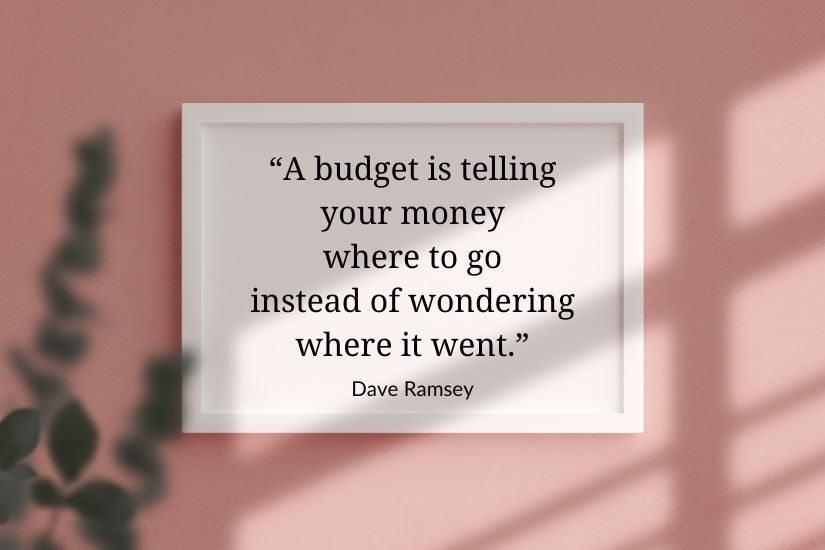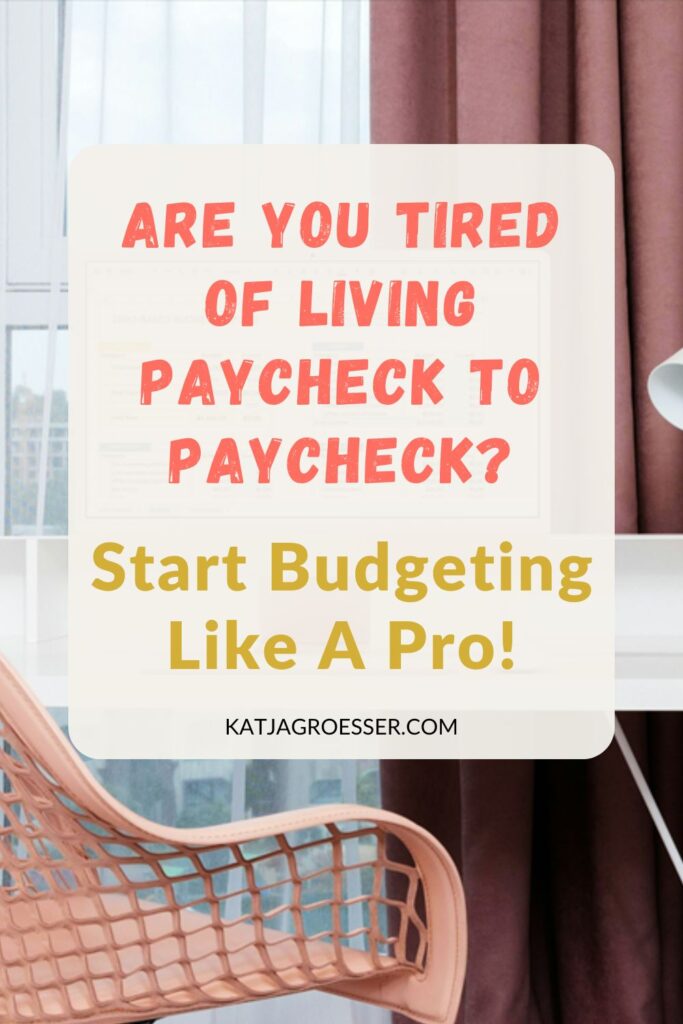This post may contain affiliate links. Please read my disclaimer for more information.
Unlock the Power of Blogging!
Ready to expand your reach and solidify your online presence? This free 5-day course will guide you step-by-step to create a clean, beautiful blog that amplifies your voice.
Nowadays I talk about budgeting as if it’s been my passion forever. You might call me a little obsessed—and honestly, that wouldn’t be wrong! I discovered that budgeting completely changed my financial life in ways I never expected. Now, I want to tell every woman: start budgeting like a pro!
Budgeting is one of the most powerful financial tools, and it can move you toward financial freedom faster than you’d think. If you’re someone who feels budgeting is too complicated, time-consuming, or restrictive, I get it. I was right there, too! I used to think, “Why should I budget? I’m not having financial problems. Isn’t that just for people who are struggling?”
But as I learned more, I realized budgeting is about so much more than solving financial problems.
It’s about building control, clarity, and confidence with your money.
This completely shifted my financial mindset. Since that moment, I’ve dedicated myself to learning everything about budgeting. And now I’m here to show you how it can start budgeting like a pro, too.
- Ready to Start Budgeting Like a Pro? Here’s Why It’s the Key to Your Financial Freedom!
- Uncovering Your Financial Starting Point: A Clear Path to Take Control of Your Money
- Mastering the Mindset: Transform How You Think About Budgeting
- Unlock Your Financial Potential: Start Budgeting Like a Pro Today!
- FAQs About Budgeting
- Start Budgeting Like a Pro: Your Blueprint to Achieving Financial Success!
Ready to Start Budgeting Like a Pro? Here’s Why It’s the Key to Your Financial Freedom!
Imagine having complete control over your money—knowing where every dollar goes and seeing it work toward your goals. Sounds empowering, right?
Budgeting can feel intimidating, but it’s truly one of the most powerful tools for taking charge of your financial life. It’s not just about saying “no” to things you enjoy; it’s about creating a path to financial freedom. With a budget, you decide what you want your money to do.
No more guessing or stressing over unpaid bills or missed savings goals. Instead, imagine the freedom that comes with knowing every dollar that every dollar is on its right way.
These shifts in my mindset helped me to start budgeting like a pro. I realized that creating my financial future was entirely within my control.
With a budget, you can prioritize spending, save intentionally, and best of all—enjoy purchases guilt-free!
Whether you’re just beginning or looking to refine your strategy, these five simple steps will make budgeting easy, approachable, and maybe even a little fun. Stick around to the end for a free budgeting checklist to help you get started today!

Uncovering Your Financial Starting Point: A Clear Path to Take Control of Your Money
Before you can start budgeting like a pro, you need to know where you are financially. This means more than just listing your expenses—it’s about assessing your financial starting point.
So, what does that look like?
In simple terms, it’s your net worth. This single number tells you exactly where you stand financially right now and gives you a complete picture of your current situation.
Once you know your net worth, the next step is to see where your money is actually going—meaning all your expenses.
Take a look at your recent bank statements and bills. Track your spending over the last month and see where most of your money is going. You’ll likely find some areas where you can cut back or adjust spending to better support your goals. It might sound tedious, but this clear picture of your spending habits is the foundation of effective budgeting.
If you’re unsure where to cut expenses, don’t worry; you can revisit that later. For now, just be honest with yourself about every dollar spent. This honesty is key to making your budget work for you, not against you.

Quick Tip: Set aside 30 minutes every month to review your expenses and income. It’s a small time investment that brings clarity and control.
Mastering the Mindset: Transform How You Think About Budgeting
Your journey to financial freedom isn’t just about budgeting, saving, and investing more—it’s also about shifting your mindset. And trust me, that shift matters.
When I transitioned from a scarcity mindset to one of abundance, managing my finances became much easier. Sure, challenges still arise, but now I decide how I want to handle them with confidence and purpose.
Before you start budgeting like a pro, let’s learn to think like a pro. Instead of seeing your budget as restrictive, view it as your best ally—your guide to making the most of every dollar.
- Why think of a budget as something that holds you back?
- Why not think of it as a tool that helps you say “yes” to what truly matters?
A budget isn’t about depriving yourself—it’s about freeing up resources to pursue your dreams, travel, and enjoy small splurges without guilt.

By setting aside money for savings, investments, and fun, you’re intentionally directing your finances toward your goals. This intentional approach helps you feel more connected to every dollar and creates a sense of satisfaction as you see your progress.
Ready to get practical? Let’s start budgeting like a pro.
Unlock Your Financial Potential: Start Budgeting Like a Pro Today!
Now for the fun part—creating your budget! If you’ve followed the steps above, you’re ready to simplify this process. Grab a pen and paper, or open an Excel or Google Sheet. Keep it straightforward for now, focusing on building a functional budget without worrying about complex techniques.
There’s no “right” tool for budgeting, but I personally recommend starting with pen and paper. Writing down your numbers can help you connect with them better. Later, you can switch to an app like YNAB or Dollarbird if that suits you.
For this budget, we’re using the zero-based method!
In this approach, every dollar has a purpose: your income minus your expenses equals zero. Whether for spending, saving, or investing, each part of your income is assigned a specific role so there’s no “extra” money at month’s end.
Don’t worry, this doesn’t mean you’ll run out of money! Everything is planned for, down to the last dollar, so you’re covered in advance.
If another rule works for you, that’s great! But with the zero-based approach, you can create your own structure, putting every dollar exactly where you want it to go.
Step 01 List All Your Income and Expenses
Since we’ll be subtracting expenses from income to create our budget, we need to know both amounts clearly. Earlier, I suggested tracking these numbers, and now it’s time to write them down.
- Start by listing all sources of income—your salary, side gigs, and any other earnings.
- Then, categorize your expenses, such as housing, groceries, entertainment, and savings. Don’t forget to include any debt payments as well, as they’re a crucial part of your financial picture.
Having everything written down will make the budgeting process straightforward and help ensure you’re not overlooking any important details.
Step 02 Create Spending Categories
With your expenses in hand, start by grouping them into major spending categories like essentials, savings, and “wants.” This step is key to creating a flexible budget that you can easily adjust as you go.
Essentials might include housing, utilities, groceries, and debt payments, while savings and investments can be grouped separately. Then, there are “wants,” like dining out, entertainment, and hobbies.
Organizing your expenses in this way gives you a clear picture of where your money goes, and you can easily adjust your budget to better fit your goals.
Step 03 Set Limits
Now comes the most challenging step: determining how much you can spend in each category. This is an honest question you need to confront.
While your fixed expenses, like rent or mortgage, are straightforward, variable expenses can be trickier. Use the numbers you’ve calculated for the past month as a guideline to set realistic limits. It’s better to plan for spending under your budget than to exceed it.
For instance, if your budget allows $300 for food, aim to stick to that amount.
- Start by allocating a portion of your income to each category, prioritizing essentials—like housing and debt payments—first.
- Next, allocate funds for savings and investments.
- Only after covering these should you allocate money for your “wants.”
The ultimate goal is to ensure that your income exceeds your expenses, giving you the financial flexibility to build your future.
Step 04 Track Your Spending
This part is crucial: record every expense, even the small ones. You might think this will be the most time-consuming task, but it really isn’t! In fact, it takes only about 10 minutes a day to jot down your daily expenses. Keeping track daily is far easier than trying to catch up once a week.
One major benefit of this practice is that it allows you to spot mistakes in your budget or instances of overspending right away, enabling you to react quickly and adjust as needed.
Finding just 10 minutes a day is entirely doable. Think about a time when you spend 10 minutes, like scrolling through social media.
Why not use that time more mindfully for your financial future instead?
Your budget will thank you!
Step 05 Adjust Monthly
Life changes, and so will your budget. That’s why it’s essential to review and adjust it as needed, with a good time to do this being at the end of each month.
Every month, when I wrap up my previous budget, I take the time to review it thoroughly. This process allows me to track my mistakes and celebrate my wins. By learning from each month, I can apply those insights to create a more effective budget for the new month.
Over the years, I’ve gotten better and better at budgeting. But life is never static, and our budgets need to reflect those changes continuously.
To start budgeting like a pro, it’s not just about creating a budget—it’s about learning, adjusting, and consistently refining your approach.
Embrace the process, and you’ll find budgeting becomes easier and more intuitive over time.

Tracking each category has helped me identify areas where I can cut back without sacrificing what truly matters to me. This process has made me much more mindful about my spending habits.
Now, let’s address some common questions people have when they’re starting to budget. These FAQs can help clarify any uncertainties and provide you with the confidence to gain control of your financial journey!
FAQs About Budgeting
Start Budgeting Like a Pro: Your Blueprint to Achieving Financial Success!
Now you’re fully equipped to start budgeting like a pro! It’s your turn to tell your money where to go.
Remember, budgeting isn’t about restriction; it’s about creating freedom and control over your financial future.
With these five simple steps, you’re on your way to achieving financial peace and moving closer to your dreams—whether that means traveling, investing, or planning for retirement. Embrace the journey, stay committed, and watch how your financial confidence grows!
Come back again by saving this post to your favorite Pinterest board👇.


